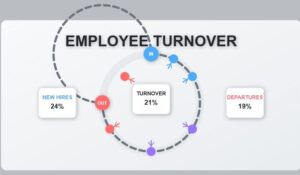Diversity, Equity, and Inclusion (DEI) have become essential components of building a successful and inclusive workplace. Organizations are recognizing the value of embracing diversity and creating an environment where everyone feels respected, valued, and included. Companies that prioritize DEI initiatives tend to experience increased innovation, employee satisfaction, and productivity. Let us explore in detail, the importance of DEI in the workplace and several other DEI factors that you will find useful.
DEI Defined
DEI stands for Diversity, Equity, and Inclusion. Diversity refers to the range of individual differences, including but not limited to race, ethnicity, gender, sexual orientation, age, disability, and religion. It encompasses the unique qualities and characteristics that make each person who they are. In a diverse society, individuals come from various backgrounds, cultures, and experiences, bringing a wealth of perspectives and ideas to the table.
Equity, on the other hand, focuses on ensuring fairness and equality in treatment, opportunities, and advancement for all members of the organization. It recognizes that not everyone starts from the same place and that certain groups may face systemic barriers that hinder their progress. By promoting equity, organizations strive to create an environment where everyone has an equal chance to succeed, regardless of their background or circumstances.
Inclusion is a vital component of DEI, aiming to create an environment where diverse individuals can fully participate, contribute, and feel a sense of belonging. It goes beyond simply having a diverse workforce or diverse representation within an organization. Inclusion means actively valuing and respecting different perspectives, ideas, and contributions. It involves creating a culture that embraces diversity and empowers individuals to bring their authentic selves to work.
Importance of Prioritizing DEI in Your Organization
When organizations prioritize DEI, they recognize that diversity alone is not enough. It is not sufficient to have a workforce that represents different backgrounds if those individuals do not feel included or valued. By fostering an inclusive environment, organizations can tap into the full potential of their diverse talent, leading to increased innovation, creativity, and overall success.
Moreover, DEI is not just a moral imperative but also a business imperative. Research has consistently shown that diverse and inclusive organizations outperform their counterparts. By embracing diversity, equity, and inclusion, organizations can attract top talent, enhance employee engagement and satisfaction, improve decision-making processes, and better understand and serve their diverse customer base.
DEI is a multifaceted concept that encompasses diversity, equity, and inclusion. It is about recognizing and valuing the unique qualities and experiences that individuals bring, promoting fairness and equality, and creating an inclusive environment where everyone can thrive. By prioritizing DEI, organizations can unlock the full potential of their workforce and drive sustainable success.
The Importance of Diversity, Equity, and Inclusion in the Workplace
A diverse workforce brings together individuals with varied perspectives, experiences, and leadership skills. This diverse talent pool fosters creativity, promotes innovation, and enhances problem-solving capabilities. Furthermore, studies have consistently shown that diverse teams make better decisions and deliver better financial outcomes. DEI initiatives also contribute to attracting and retaining top talent, improving employee morale and satisfaction, and enhancing company reputation.
One of the key benefits of diversity in the workplace is the ability to tap into a wide range of perspectives. When employees come from different backgrounds, they bring with them unique insights and ideas that can lead to innovative solutions. For example, a team composed of individuals from different cultures and ethnicities can offer diverse approaches to problem-solving, drawing from their distinct experiences and knowledge. This diversity of thought can drive creativity and help organizations stay ahead in a rapidly changing business landscape.
In addition to fostering creativity and innovation, diversity in the workplace has been proven to enhance problem-solving capabilities. When a team is made up of individuals with different skill sets and experiences, they can collectively tackle complex challenges more effectively. Diverse teams are more likely to consider a wider range of perspectives and potential solutions, leading to more comprehensive and successful problem-solving outcomes. This ability to approach problems from multiple angles can give organizations a competitive edge and enable them to adapt to evolving market demands.
Moreover, research has consistently shown that diverse teams make better decisions and achieve better financial outcomes. When individuals from different backgrounds come together, they bring a variety of viewpoints and approaches to decision-making. This diversity of perspectives helps to minimize biases and groupthink, leading to more balanced and well-informed decisions. As a result, organizations with diverse teams are more likely to make strategic choices that drive growth and profitability.
Scope of Diversity at Work
Beyond the business benefits, diversity, equity, and inclusion (DEI) initiatives also play a crucial role in attracting and retaining top talent. In today’s competitive job market, candidates prioritize workplaces that value diversity and provide equal opportunities for all. Companies that prioritize DEI initiatives are more likely to attract a diverse pool of candidates, including individuals from underrepresented groups. By creating an inclusive environment where everyone feels valued and supported, organizations can retain top talent and foster a positive work culture.
Furthermore, DEI initiatives have a direct impact on employee morale and satisfaction. When employees feel that their voices are heard and their contributions are valued, they are more likely to be engaged and motivated. Inclusive workplaces promote a sense of belonging and create opportunities for personal and professional growth. This, in turn, leads to higher job satisfaction, increased productivity, and reduced turnover rates.
Diversity, equity, and inclusion efforts contribute to enhancing a company’s reputation. In today’s socially conscious world, consumers and stakeholders expect businesses to prioritize diversity and equality. Companies that demonstrate a commitment to DEI initiatives are seen as more ethical and socially responsible, which can positively impact their brand image and customer loyalty. By championing diversity in the workplace, organizations can build a strong reputation and gain a competitive advantage in the marketplace.
Creating a Culture of Inclusion: Best Practices for Employers
Building a culture of inclusion requires intentional effort and commitment from employers. It is not enough to simply have diversity in the workplace; employers must actively work towards creating an environment where every employee feels valued, respected, and included. Here are some best practices that can help employers in their journey towards fostering a culture of inclusion:
-
Leadership commitment:
Leadership must actively support and champion DEI (Diversity, Equity, and Inclusion) efforts. When leaders demonstrate a genuine commitment to creating an inclusive workplace, it sets the tone for the entire organization. Leaders should not only talk about the importance of inclusion but also take concrete actions to promote diversity and equity within the company.
-
Unbiased policies and practices:
Ensuring fair and equitable policies and practices in recruitment, promotion, and compensation is crucial for creating a culture of inclusion. Employers should regularly review their policies to identify and eliminate any biases that may exist. This includes implementing blind hiring practices, where the focus is solely on the qualifications and skills of the candidates, rather than their demographic information.
-
Training and education:
Providing DEI training and education to all employees is essential for fostering awareness and understanding. This training should go beyond basic diversity awareness and delve into topics such as unconscious bias, cultural competence, and inclusive leadership. By equipping employees with the knowledge and skills to navigate diverse environments, employers can create a more inclusive workplace.
-
Employee resource groups:
Supporting the creation of employee resource groups (ERGs) can foster a sense of community and support. ERGs are voluntary, employee-led groups that bring together individuals with shared identities or interests. These groups provide a platform for employees to connect, share experiences, and advocate for change. Employers should provide resources and support to help ERGs thrive and make a meaningful impact within the organization.
-
Metrics and accountability:
Establishing measurable goals and regularly evaluating progress is essential for creating a culture of inclusion. Employers should set specific targets related to diversity, equity, and inclusion and track their progress over time. By holding themselves accountable and transparently sharing their progress, employers can demonstrate their commitment to creating an inclusive workplace.
-
Open communication:
Encouraging open and honest dialogue about DEI issues and concerns is crucial for creating an inclusive culture. Employers should create safe spaces for employees to share their experiences, ask questions, and provide feedback. This can be done through town hall meetings, anonymous suggestion boxes, or regular check-ins with employees. By actively listening to their employees’ voices, employers can address any challenges or barriers to inclusion.
For employers seeking to implement and maintain a culture of inclusion, HubEngage provides the right tools and technology to foster effective communication and engagement among employees. HubEngage offers a comprehensive employee engagement platform that enables employers to connect with their workforce, share important information, and create a sense of belonging. With features like mobile apps, surveys, recognition programs, and communication tools, HubEngage empowers employers to build a culture of inclusion that drives employee satisfaction, productivity, and retention.
Forming A Good DEI Strategy
A well-defined DEI (Diversity, Equity, and Inclusion) strategy is crucial for organizations to achieve their diversity and inclusion goals. An effective DEI strategy goes beyond mere lip service and requires a thoughtful and intentional approach.
One of the key components of a successful DEI strategy is conducting an assessment of the organization’s current state of diversity and inclusion. This assessment involves taking a close look at the organization’s workforce demographics, including representation at different levels and in various departments. It also involves gathering feedback from employees through surveys, focus groups, and one-on-one conversations to understand their experiences and perspectives.
Based on the findings from the assessment, organizations can then establish clear objectives and goals that align with their overall mission and values. These objectives should be specific, measurable, achievable, relevant, and time-bound (SMART). For example, an organization might set a goal to increase the representation of underrepresented groups in leadership positions by a certain percentage within a specified timeframe.
DEI in HR
Once the objectives and goals are established, it is crucial to develop actionable steps to recruit, retain, and promote diverse talent. This involves implementing inclusive hiring practices, such as actively sourcing candidates from underrepresented groups, using diverse interview panels, and ensuring equitable compensation and advancement opportunities. Organizations should also focus on creating an inclusive culture where all employees feel valued and have equal access to resources and opportunities for growth.
Regular measurement and evaluation of progress are essential to track the effectiveness of the DEI strategy. This involves collecting and analyzing data on key diversity and inclusion metrics, such as representation, employee engagement, and retention rates. By regularly reviewing and assessing the data, organizations can identify areas of improvement and make necessary adjustments to their DEI initiatives.
Implementing and reinforcing a DEI strategy requires effective communication channels. This is where HubEngage’s comprehensive communication channels come into play. With mobile apps, web intranet platforms, email, SMS, and digital signage, organizations can reach their employees across various touchpoints and ensure that the DEI strategy is effectively communicated and reinforced. These communication channels provide a platform for sharing success stories, highlighting diversity and inclusion initiatives, and fostering ongoing dialogue and engagement among employees.
A well-defined DEI strategy is a critical component of any organization’s success in fostering a diverse and inclusive workplace. By conducting an assessment, setting clear objectives, taking actionable steps, and regularly measuring progress, organizations can create an environment where all employees feel valued, included, and empowered to contribute their unique perspectives and talents.
Overcoming Challenges in Implementing DEI Strategies
Implementing DEI strategies can be complex and pose challenges for organizations. Common challenges include:
- Resistance to change:
Addressing resistance from employees who may be unfamiliar or uncomfortable with DEI initiatives. - Lack of awareness and training:
Providing adequate training and education to employees to build awareness and foster inclusivity. - Unconscious bias:
Developing strategies to mitigate unconscious bias in recruitment, promotion, and decision-making processes. - Measuring effectiveness:
Identifying appropriate metrics and evaluation methods to measure the effectiveness of DEI initiatives.
HubEngage’s DEI tools and technology help organizations overcome these challenges by offering dynamic communication platforms that enable educational training, awareness campaigns, and transparent measurement of DEI progress.
The Role of Leadership in Driving DEI Efforts
Leadership plays a vital role in driving DEI efforts within an organization. When leaders demonstrate a commitment to diversity and inclusion, it sets the tone for the entire organization. Encouraging open dialogue, leading by example, and actively participating in DEI initiatives empowers employees and reinforces the importance of creating an inclusive workplace culture. HubEngage supports leadership engagement through its diverse communication channels, enabling leaders to communicate directly and effectively with their teams.
Empowering Employees through DEI Training and Education
DEI training and education are essential components of fostering an inclusive workplace. HubEngage provides organizations with the means to deliver engaging training programs that educate employees about unconscious bias, cultural competence, and the importance of diversity and inclusion. By offering mobile apps, web platforms, and email communication, HubEngage ensures that all employees can access these resources conveniently and participate in their own time.
DEI Statement Examples
A DEI statement is an official statement from an organization that outlines its commitment to diversity, equity, and inclusion. Here are some examples of strong DEI statements:
- “At HubEngage, we are dedicated to fostering an inclusive environment where every employee feels valued, respected, and empowered. We embrace diversity in all its forms and strive to create equal opportunities for growth and success.”
- “Diversity and inclusion are at the core of our organization’s values. We believe that everyone deserves to be treated fairly, regardless of their race, gender, age, or background. We are committed to building an inclusive workplace that celebrates our differences and promotes collaboration.”
HubEngage not only supports the creation of impactful DEI statements but also provides the tools to transform these statements into actionable workplace culture.
How to Transform the DEI Statement into Workplace Culture
Transforming a DEI statement into actual workplace culture requires consistent effort and ongoing commitment. Here are some steps organizations can take:
- Lead by example: Ensure that leaders embody the values outlined in the DEI statement.
- Employee engagement: Encourage employee involvement in DEI initiatives and provide opportunities for feedback and suggestions.
- Training and education: Offer continuous DEI training programs to reinforce and deepen understanding.
- Recognition and rewards: Recognize and reward individuals and teams that promote diversity and inclusion in the workplace.
HubEngage’s communication channels facilitate real-time feedback, recognition, and engagement, enabling organizations to embed diversity and inclusion in their day-to-day operations.
Ideas for DEI Activities at Work
Organizations can implement various DEI activities to foster inclusivity and celebrate diversity.
- Cultural showcases: Organize events to celebrate different cultures, traditions, and holidays.
- Mentorship programs: Establish mentorship programs to support the growth and development of diverse talent.
- Employee resource groups: Encourage the formation of employee resource groups focused on different affinity groups.
- Volunteer initiatives: Engage in community service and volunteer activities that promote social justice and equality.
HubEngage’s comprehensive communication channels facilitate the planning and execution of these activities, ensuring maximum participation and impact.
Hiring a DEI Officer
Hiring a dedicated DEI Officer can significantly enhance an organization’s DEI efforts. A DEI Officer is responsible for developing and implementing strategies to promote diversity, equity, and inclusion throughout the organization. They advocate for change, provide training and education, establish metrics for success, and work collaboratively with leadership and employees.
Through its various communication channels, HubEngage offers a platform for transparent communication and collaboration between the DEI Officer and employees.
DEI Interview Questions to Ask During Recruitment
During the recruitment process, it is crucial to ask questions that assess a candidate’s alignment with an organization’s DEI values.
- “Can you provide examples of how you have worked effectively with individuals from diverse backgrounds?”
- “How would you contribute to creating an inclusive and equitable workplace environment?”
- “Tell us about a time when you had to challenge biased thinking or behavior.”
HubEngage’s communication channels offer an efficient way to streamline the recruitment process and collaborate on candidate evaluation and selection.
Setting Achievable DEI Goals
Setting achievable DEI goals is essential to track progress and ensure continuous improvement.
- Increase representation of underrepresented groups in leadership positions by 20% within the next two years.
- Conduct annual DEI training for all employees and track participation rates.
- Create a mentoring program that pairs diverse talent with senior leaders.
HubEngage’s communication channels offer the ability to track and measure progress towards these goals, providing organizations with valuable insights and data for evaluation.
Creating a DEI Score for Employees and the Organization
Creating a DEI score allows organizations to assess their progress in creating an inclusive workplace. A DEI score can include metrics such as representation, employee satisfaction, engagement, and diversity training participation rates. By providing comprehensive communication channels, HubEngage enables companies to collect, analyze, and report data to create meaningful DEI scores for both employees and the organization.
Measuring Success: Key Metrics for Evaluating DEI Progress
Measuring the success of DEI initiatives is crucial to ensure continuous improvement. Key metrics for evaluating DEI progress include:
- Representation: Assessing the diversity of employees at all levels of the organization.
- Employee satisfaction: Gauging employee satisfaction through surveys and feedback mechanisms.
- Retention rates: Tracking the retention rates of underrepresented groups.
- Promotion rates: Analyzing promotion rates and opportunities for diverse talent.
HubEngage’s communication channels provide the means to collect and analyze data, enabling organizations to evaluate the effectiveness of their DEI initiatives.
The Future of DEI: Trends and Innovations in Workforce Diversity
As workforce diversity continues to evolve, organizations must stay ahead by embracing emerging trends and innovations. Some key trends in the future of DEI include:
- Technology-driven solutions:
Leveraging technology to drive DEI initiatives, improve accessibility, and foster inclusive communication. - Intersectionality and allyship:
Recognizing and addressing the interconnected nature of various aspects of diversity and promoting allyship among employees. - Data-driven decision-making:
Using data analytics to identify areas of improvement and make informed DEI decisions. - Continued advocacy:
Advocating for diversity, equity, and inclusion on a broader scale in society and within organizations.
HubEngage, with its cutting-edge communication channels, is at the forefront of these trends, enabling organizations to navigate the future of DEI successfully.
HubEngage: The Best Choice for DEI Implementation
When it comes to implementing and nurturing a strong DEI strategy, HubEngage stands out as the best choice for organizations. HubEngage offers a comprehensive communication platform that includes mobile apps, web, email, SMS, and digital signage. This diversity of communication channels ensures that organizations can reach and engage all employees, regardless of their preferences or location.
Furthermore, HubEngage provides organizations with the tools and technology necessary to embed diversity, equity, and inclusion into the organization’s DNA. From DEI training programs to real-time recognition and measurement capabilities, HubEngage facilitates the creation of an inclusive workplace culture, enabling organizations to reap the benefits of a diverse workforce.
DEI is crucial for building successful and inclusive workplaces. HubEngage, with its comprehensive communication channels and DEI-focused tools and technology, is the best choice for organizations seeking to implement, nurture, and evaluate their DEI strategies. By choosing HubEngage, organizations can foster a culture of inclusion, improve employee engagement and satisfaction, and stay ahead of the evolving trends in workforce diversity.
Ready to elevate your DEI initiatives and transform your workplace culture?
Experience the power of HubEngage, the award-winning platform designed to streamline your internal communications and foster a truly inclusive environment. With our custom branded Apps, personalized content, and extensive automation features, you’ll save time and engage your workforce like never before. Embrace the future of DEI with our multi-language support, gamification, and exceptional customer service. Take the first step towards a more connected and diverse organization.
See a demo of HubEngage today and witness the impact of a unified communication platform on your DEI strategy.
Check out the recording of our DEI Webinar.













